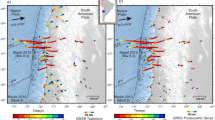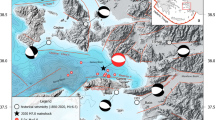Abstract
The recent 24 August 2016, M W = 6.0, Amatrice earthquake (central Italy) and the resulting aftershock sequence represents a test case to investigate the static and dynamic stress/strain contribution to the triggering of the sequence. Here we test the hypothesis that either static or dynamic stress contribution alone may not be sufficient to explain the aftershock distribution. We first inferred the horizontal source rupture directivity together with an estimate of the surface fault projection from the analysis of the peak-ground velocity. We computed the peak-dynamic strain field, modified by source directivity, using the peak-ground velocity as a strain proxy and the Coulomb static stress change. Finally, we compared the seismicity rate map (β-statistic) with each of the estimated fields to investigate correlations with the aftershock pattern. We found that the area of the highest values of the estimated peak-dynamic strain field better reproduces the observed asymmetry in the aftershock distribution. This suggests that, in addition to Coulomb static stress change, dynamic strain enhanced by source directivity, contributed to the triggering of the Amatrice earthquake aftershocks.






Similar content being viewed by others
References
Ben-Menahem, A. (1961). Radiation of seismic surface waves from finite moving sources. Bulletin of the Seismological Society of America, 51(3), 401–435.
Bindi, D., Pacor, F., Luzi, L., Puglia, R., Massa, M., Ameri, G., et al. (2011). Ground motion prediction equations derived from the Italian strong motion data base. Bulletin of Earthquake Engineering, 9(6), 1899–1920.
Boatwright, J. (2007). The persistence of directivity in small earthquakes. Bulletin of the Seismological Society of America, 97(6), 1850–1861.
Brodsky, E. E., & van der Elst, N. J. (2014). The uses of dynamic earthquake triggering. Annual Review of Earth and Planetary Sciences, 42(42), 317–339. doi:10.1146/Annurev-Earth-060313-054648.
Cirella, A., Piatanesi, A. (2016). Source complexity of the 2016 Amatrice earthquake from non linear inversion of strong motion data: Preliminary results. doi:10.5281/zenodo.153821.
Convertito, V., Caccavale, M., De Matteis, R., Emolo, A., Wald, D., & Zollo, A. (2012). Fault extent estimation for near-real-time ground-shaking map computation purposes. Bulletin of the Seismological Society of America, 102(2), 661–679.
Convertito, V., Catalli, F., & Emolo, A. (2013). Combining stress transfer and source directivity: The case of the 2012 Emilia seismic sequence. Scientific Reports, 3, 3114. doi:10.1038/srep03114.
Convertito, V., De Matteis, R., & Emolo, A. (2016a). Investigating triggering of the aftershocks of the 2014 Napa earthquake. Bulletin of the Seismological Society of America, 106(5), 2063–2070. doi:10.1785/0120160011.
Convertito, V., & Emolo, A. (2012). Investigating rupture direction for three 2012 moderate earthquakes in northern Italy from inversion of peak-ground motion parameters. Bulletin of the Seismological Society of America, 102(6), 2764–2770.
Convertito, V., Pino, N. A., & Di Luccio, F. (2016b). Investigating source directivity of moderate earthquakes by multiple approach: The 2013 Matese (southern Italy) M W = 5 event. Geophysical Journal International, 207, 1513–1528. doi:10.1093/gji/ggw360.
Douglas, J. (2006). Estimating strong ground motion at great depths, Third International Symposium on the Effects of Surface Geology on Seismic Motion, Grenoble, France, 30 August–1 September 2006.
Draper, N. R., & Smith, H. (1998). Applied regression analysis (3rd ed.). New Jersey: Wiley.
El Hariri, M., Abercrombie, R. E., Rowe, C. A., & Do Nascimento, A. F. (2010). The role of fluids in triggering earthquakes: Observations from reservoir induced seismicity in Brazil. Geophysical Journal International, 181, 1566–1574. doi:10.1111/j.1365-246X.2010.04554.x.
Elkhoury, J. E., Brodsky, E. E., & Agnew, D. C. (2006). Seismic waves increase permeability. Nature, 441, 1135–1138. doi:10.1038/nature04798.
Freed, A. M. (2005). Earthquake triggering by static, dynamic, and postseismic stress transfer. Annual Review of Earth and Planetary Sciences, 33, 335–367. doi:10.1146/annurev.earth.33.092203.122505.
Gomberg, J., Bodin, P., & Reasenberg, P. A. (2003). Observing earthquakes triggered in the near field by dynamic deformations. Bulletin of the Seismological Society of America, 93(1), 118–138.
Gomberg, J., Reasenberg, P. A., Bodin, P., & Harris, R. A. (2001). Earthquake triggering by seismic waves following the Landers and Hector Mine earthquakes. Nature, 411, 462–466.
Herrmann, R. B., Malagnini, L., & Munafò, I. (2011). Regional moment tensor of the 2009 L’Aquila earthquake sequence. Bulletin of the Seismological Society of America, 101(3), 975–993.
Hill, D. P., et al. (1993). Seismicity remotely triggered by the magnitude 7.3 Landers, California, earthquake. Science, 260, 1617–1623.
Joyner, W. B. (1991). Directivity for non-uniform ruptures. Bulletin of the Seismological Society of America, 81(4), 1391–1395.
Kilb, D., Gomberg, J., & Bodin, P. (2000). Triggering of earthquake aftershocks by dynamic stresses. Nature, 408, 570–574.
Lin, J., & Stein, R. S. (2004). Stress triggering in thrust and subduction earthquakes, and stress interaction between the southern San Andreas and nearby thrust and strike-slip faults. Journal of Geophysical Research, 109, B02303. doi:10.1029/2003JB002607.
Michele, M., Di Stefano, R., Chiaraluce, L., Cattaneo, M., De Gori, P., Monachesi, G., Latorre, D., Marzorati, S., Valoroso, L., Ladina, C., Chiarabba, C., Lauciani, V., Fares, M. (2016). The Amatrice 2016 seismic sequence: A preliminary look to the mainshock and aftershocks distribution. Annals of Geophysics, 59, Fast Track 5: The Amatrice seismic sequence: Preliminary data and results. doi:10.4401/ag-7227.
Michelini, A., Faenza, L., Lauciani, V., & Malagnini, L. (2008). ShakeMap implementation in Italy. Seismological Research Letters, 79(5), 688–697.
Montuori, C., Murru, M., & Falcone, G. (2016). Spatial variation of the b-value observed for the periods preceding and following the 24 August 2016, Amatrice earthquake (M L 6.0) (Central Italy). Annals of Geophysics. doi:10.4401/ag-7273. (Fast Track 5, 2016).
Pino, N. A., & Di Luccio, F. (2009). Source complexity of the 6 April 2009 L’Aquila (central Italy) earthquake and its strongest aftershock revealed by elementary seismological analysis. Geophysical Research Letters, 36, L23305. doi:10.1029/2009GL041331.
Pino, N. A., Mazza, S., & Boschi, E. (1999). Rupture directivity of the major shocks in the 1997 Umbria-Marche (central Italy) sequence from regional broadband waveforms. Geophysical Research Letters, 26, 2101–2104.
Pischiutta, M., Akinci, A., Malagnini, L., & Herrero, A. (2016). Characteristics of the strong ground motion from the 24th August 2016 Amatrice earthquake. Annals of Geophysics. doi:10.4401/AG-7219. (Fast Track 5, 2016).
Pondrelli, S., Salimbeni, S., & Perfetti, P. (2016). Moment tensor solutions for the Amatrice 2016 seismic sequence. Annals of Geophysics. doi:10.4401/ag-7240. (Fast Track 5, 2016).
Reasenberg, P. A., & Simpson, R. W. (1992). Response of regional seismicity to the static stress change produced by the Loma Prieta earthquake. Science, 255, 1687–1690.
Spagnuolo, E., Cirella, A., & Akinci, A. (2016). Investigating the effectiveness of rupture directivity during the August 24, 2016 M w 6.0 central Italy earthquake. Annals of Geophysics. doi:10.4401/ag-7213. (Fast Track 5, 2016).
Stein, R. S. (1999). The role of stress transfer in earthquake occurrence. Nature, 402, 605–609.
Talwani, P., Chen, L., & Gahalaut, K. (2007). Seismogenic permeability, ks. Journal of Geophysical Research, 112, B07309. doi:10.1029/2006JB004665.
Tinti, E., Scognamiglio, L., Michelini, A., & Cocco, M. (2016). Slip heterogeneity and directivity of the M L 6.0, 2016, Amatrice earthquake estimated with rapid finite-fault inversion. Geophysical Research Letters, 43(20), 10745–10752. doi:10.1002/2016GL071263.
Toda, S., Stein, R. S., Lin, J., Sevilgen, V. (2011). Coulomb 3.3 graphic-rich deformation and stress-change software for earthquake, tectonic, and volcano research and teaching—User guide, U.S. Geological Survey Open-File Report 2011-1060, p 63.
Valoroso, L., Chiaraluce, L., Piccinini, D., Di Stefano, R., Schaff, D., & Waldhauser, F. (2013). Radiography of a normal fault system by 64,000 high-precision earthquake locations: The 2009 L’Aquila (central Italy) case study. Journal of Geophysical Research, 118, 1156–1176. doi:10.1002/jgrb.50130.
van der Elst, N. J., & Brodsky, E. E. (2010). Connecting near-field and far-field earthquake triggering to dynamic strain. Journal of Geophysical Research, 115, B07311. doi:10.1029/2009JB006681.
Author information
Authors and Affiliations
Corresponding author
Rights and permissions
About this article
Cite this article
Convertito, V., De Matteis, R. & Pino, N.A. Evidence for Static and Dynamic Triggering of Seismicity Following the 24 August 2016, M W = 6.0, Amatrice (Central Italy) Earthquake. Pure Appl. Geophys. 174, 3663–3672 (2017). https://doi.org/10.1007/s00024-017-1559-1
Received:
Accepted:
Published:
Issue Date:
DOI: https://doi.org/10.1007/s00024-017-1559-1




